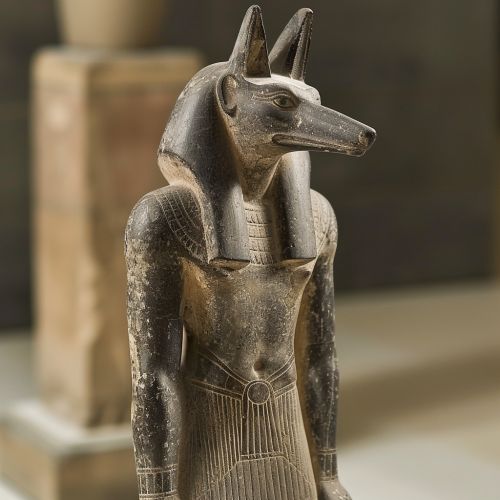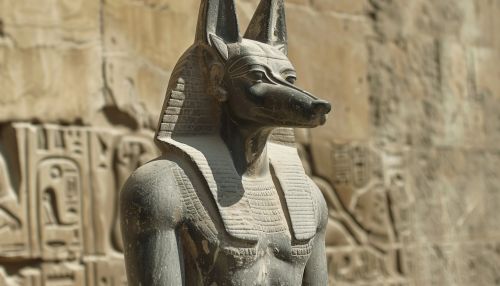Anubis: Difference between revisions
(Created page with "== Introduction == <div class='only_on_desktop image-preview'><div class='image-preview-loader'></div></div><div class='only_on_mobile image-preview'><div class='image-preview-loader'></div></div> Anubis is a deity associated with the afterlife and mummification in ancient Egyptian religion. He is typically depicted as a man with the head of a jackal, a symbol closely linked to cemeteries and the protection of the dead. Anubis played a crucial role in the journey of...") |
No edit summary |
||
| Line 1: | Line 1: | ||
== Introduction == | == Introduction == | ||
[[Image:Detail-91369.jpg|thumb|center|An ancient Egyptian statue of Anubis, depicted as a man with the head of a jackal, standing in a protective stance.|class=only_on_mobile]] | |||
[[Image:Detail-91370.jpg|thumb|center|An ancient Egyptian statue of Anubis, depicted as a man with the head of a jackal, standing in a protective stance.|class=only_on_desktop]] | |||
Anubis is a deity associated with the afterlife and mummification in ancient Egyptian religion. He is typically depicted as a man with the head of a [[jackal]], a symbol closely linked to cemeteries and the protection of the dead. Anubis played a crucial role in the journey of the deceased through the [[Duat|underworld]], overseeing the embalming process and guiding souls to their final resting place. | Anubis is a deity associated with the afterlife and mummification in ancient Egyptian religion. He is typically depicted as a man with the head of a [[jackal]], a symbol closely linked to cemeteries and the protection of the dead. Anubis played a crucial role in the journey of the deceased through the [[Duat|underworld]], overseeing the embalming process and guiding souls to their final resting place. | ||
Latest revision as of 14:21, 21 June 2024
Introduction


Anubis is a deity associated with the afterlife and mummification in ancient Egyptian religion. He is typically depicted as a man with the head of a jackal, a symbol closely linked to cemeteries and the protection of the dead. Anubis played a crucial role in the journey of the deceased through the underworld, overseeing the embalming process and guiding souls to their final resting place.
Historical Background
Anubis, known as Anpu or Inpu in ancient Egyptian, is one of the oldest gods in the Egyptian pantheon, with origins tracing back to the Predynastic period. His worship was widespread, and he held significant importance throughout various dynasties. The earliest references to Anubis are found in the Pyramid Texts, where he is described as the protector of graves and the god who presides over mummification.
Iconography and Symbolism
Anubis is most commonly represented as a man with the head of a black jackal or as a full jackal. The color black symbolizes the decay of the body and the fertile soil of the Nile, which is associated with rebirth and regeneration. His iconography often includes the was-sceptre and the ankh, symbols of power and eternal life, respectively.
Role in Funerary Practices
Anubis was central to Egyptian funerary practices. He was believed to oversee the embalming process, ensuring that the body was properly preserved for the afterlife. The embalmers would often wear masks of Anubis during the mummification process, invoking his protection and guidance.
The Weighing of the Heart
One of Anubis's most critical roles was in the Weighing of the Heart ceremony, a key component of the Egyptian Book of the Dead. In this ritual, the heart of the deceased was weighed against the feather of Maat, the goddess of truth and justice. Anubis would oversee this process, ensuring that the scales were balanced. If the heart was lighter than the feather, the soul could proceed to the afterlife; if heavier, it would be devoured by the demon Ammit.
Temples and Cult Centers
Anubis did not have a large number of temples dedicated solely to him, unlike other major deities such as Amun or Ra. However, he was worshipped in various necropolises, particularly in Saqqara and Abydos. The Temple of Anubis at Karnak is one of the few known temples dedicated to him, reflecting his importance in the context of the afterlife and mummification.
Evolution and Syncretism
Over time, Anubis's role evolved, particularly during the Greco-Roman period. He became syncretized with the Greek god Hermes, resulting in the composite deity Hermanubis. This fusion reflected the blending of Greek and Egyptian religious practices and highlighted Anubis's enduring significance in guiding souls to the afterlife.
Anubis in Modern Culture
Anubis remains a popular figure in modern culture, often appearing in literature, films, and video games. His image as a guardian of the dead and a symbol of the afterlife continues to captivate the imagination, reflecting the enduring legacy of ancient Egyptian mythology.
